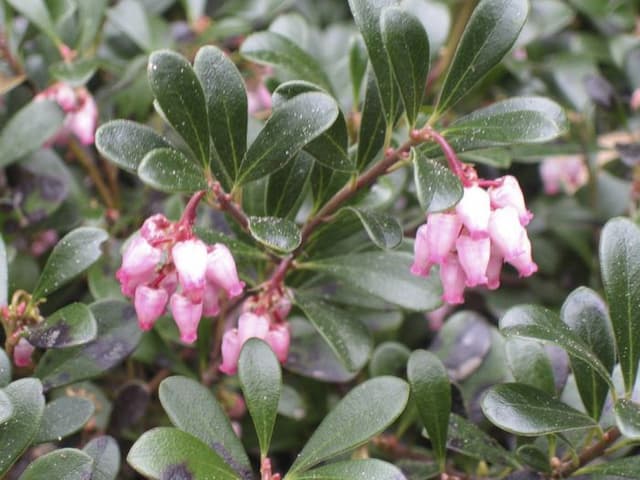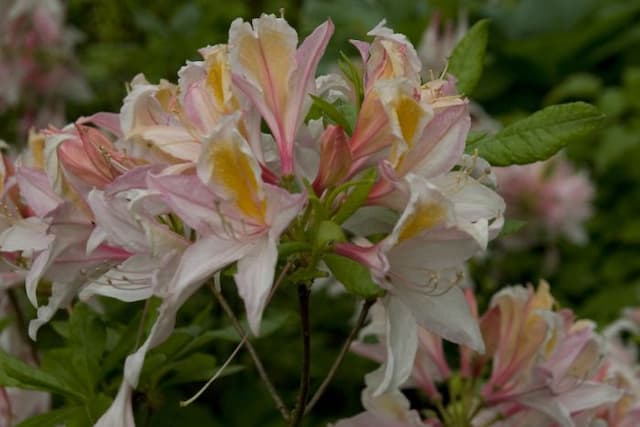Bell heather 'P.S. Patrick' Erica cinerea 'P.s. Patrick'











ABOUT
'P.S. Patrick' is a dwarf evergreen shrub of upright growth making a mat of dark foliage to 50cm in height, with erect racemes of bright purple flowers in summer and early autumn
About this plant
 Names
NamesFamily
Ericaceae
Synonyms
Bell Heather, Twisted Heath
Common names
Erica cinerea 'P.S. Patrick'.
 Characteristics
CharacteristicsLife cycle
Perennials
Foliage type
Evergreen
Color of leaves
Green
Flower color
Purple
Height
1 foot (30 cm)
Spread
1.5 feet (45 cm)
Plant type
Shrub
Hardiness zones
5
Native area
Europe
Benefits
 General Benefits
General Benefits- Ornamental Value: Adds vibrant color and texture to gardens with its bell-shaped flowers and needle-like foliage.
- Drought Tolerance: Once established, it's capable of withstanding periods of low water availability.
- Low Maintenance: Requires minimal pruning and is generally free from major pests and diseases.
- Attracts Wildlife: Provides nectar for bees and other pollinators, enhancing biodiversity.
- Soil Adaptability: Thrives in a range of soil types, including acidic, sandy, and well-drained soils.
- Year-Round Interest: Evergreen nature keeps landscapes looking lively even in colder months.
- Suitable for Containers: Can be grown in pots, making it adaptable for small spaces and patios.
- Erosion Control: Can help to stabilize soil on slopes or in areas prone to erosion.
- Versatile Use: Ideal for rock gardens, borders, groundcover, or as part of a heather collection.
 Medical Properties
Medical PropertiesThis plant is not used for medical purposes.
 Air-purifying Qualities
Air-purifying QualitiesThis plant is not specifically known for air purifying qualities.
 Other Uses
Other Uses- Erosion control: Erica cinerea, also known as bell heather, can be planted on slopes and banks to help stabilize soil and prevent erosion due to its dense matting habit.
- Dye production: The flowers and stems of bell heather can be used to create natural dyes in shades of yellow, green, and tan, useful for coloring textiles and crafts.
- Thatching: In some regions, the woody stems of bell heather have traditionally been used as a material for thatching roofs.
- Garden path borders: Due to its low-growing and spreading nature, bell heather is ideal for lining garden walkways, adding color and definition to paths.
- Wildlife habitat: Bell heather provides shelter and nesting opportunities for various insects, small mammals, and ground-nesting birds.
- Photography: Its vibrant purple flowers make bell heather a popular subject for photographers and nature enthusiasts, especially when it blooms en masse.
- Bonsai: Some gardeners use bell heather to create bonsai arrangements due to its small leaves and ability to thrive in shallow containers.
- Floral arrangements: Fresh or dried bell heather is used in floral arrangements, wreaths, and bouquets, adding texture and a splash of color.
- Education and research: Bell heather's adaptation to poor soil conditions makes it a subject of study in botany and ecology classes and research projects.
- Culinary garnish: The flowers of bell heather, while not commonly used, can be employed as an edible garnish to add a splash of color to dishes and desserts.
Interesting Facts
 Feng Shui
Feng ShuiThe Bell Heather is not used in Feng Shui practice.
 Zodiac Sign Compitability
Zodiac Sign CompitabilityThe Bell Heather is not used in astrology practice.
 Plant Symbolism
Plant Symbolism- Longevity: Erica cinerea, commonly known as Bell Heather, often represents longevity because it is a hardy plant that thrives in tough environments and blooms for a long period each year.
- Solitude: With its preference for growing in quiet, undisturbed areas, Bell Heather can symbolize a love for solitude or peacefulness.
- Protection: Traditionally, Bell Heather was thought to have protective properties, believed to guard against danger and bad luck.
- Admiration: The vibrant purple of Bell Heather's flowers can signify admiration and beauty, often given to convey one's fondness and esteem for another.
- Good fortune: In some cultures, Bell Heather is carried as a good luck charm, symbolizing the wish for prosperity and good fortune.
 Water
WaterThe Bell Heather should be watered deeply but infrequently, allowing the soil to dry out slightly between waterings. Aim to provide about one gallon of water per plant every week during the growing season, cutting back during the winter to prevent waterlogged soil, which can lead to root rot. Overwatering is a common error, so ensure the plant does not sit in water. Use a watering can or hose to gently water the soil around the base of the plant without wetting the foliage to avoid fungal diseases.
 Light
LightBell Heather thrives best in full sun to partial shade conditions. Position the plant in a location where it receives at least six hours of direct sunlight daily; however, some afternoon shade can be beneficial in extremely hot climates. Avoid deep shade as it can lead to poor flowering and leggy growth.
 Temperature
TemperatureBell Heather prefers cool to moderate temperatures and will do well in a range between 60-75°F. It can tolerate short periods of colder weather down to about 20°F and can survive brief exposure to temperatures up to 80°F. Avoid extreme heat or cold, which can be detrimental to the plant's health.
 Pruning
PruningPrune Bell Heather in late winter or early spring to maintain its shape and encourage robust growth. Trimming off spent flower spikes and lightly shaping the plant will stimulate new growth and improve blooming. Pruning should be done annually, but avoid cutting into old wood, as this can prevent the plant from flowering.
 Cleaning
CleaningAs needed
 Soil
SoilThe best soil mix for Bell Heather ('Erica cinerea 'P.S. Patrick'') is one that is well-draining, acidic, and rich in organic matter. A mix of peat moss, sand, and loam works well, aiming for a pH between 4.5-5.5. Ensure good aeration and avoid heavy, clay-rich soils.
 Repotting
RepottingBell Heather should be repotted every 2 to 3 years. It's best to repot in the spring, using fresh acidic soil mix to refresh the nutrients and maintain proper soil structure.
 Humidity & Misting
Humidity & MistingBell Heather thrives in moderate humidity conditions. It does not require excessively high humidity; average room humidity levels are generally sufficient.
 Suitable locations
Suitable locationsIndoor
Provide bright light, acidic soil, and keep at cool temperatures.
Outdoor
Plant in well-draining, acidic soil, full sun to partial shade.
Hardiness zone
5-8 USDA
 Life cycle
Life cycleErica cinerea, also known as Bell Heather, begins its life cycle with seed germination, which is dependent on the right conditions of temperature and moisture. It then progresses to a seedling stage, establishing a small root system and beginning to produce foliage. As it enters the vegetative stage, the plant develops a more robust root network and significant amounts of heather-like foliage, preparing for the onset of flowering. The reproductive phase sees the development of small, bell-shaped purple flowers, usually during the summer months. After pollination, typically by insects, seeds are produced and dispersed, completing the cycle. Over the years, Bell Heather can form woody stems and may become a small shrub, with each cycle contributing to the thickening and expansion of the plant.
 Propogation
PropogationPropogation time
Spring to Summer
The Erica cinerea 'P.S. Patrick', commonly known as bell heather, is typically propagated through semi-ripe cuttings. This process is usually carried out during the summer months when the plant's growth is active, but the stems are not yet fully matured. To propagate bell heather, you take a cutting of about 2 to 4 inches (5 to 10 centimeters) from a healthy parent plant. The leaves on the lower half of the cutting are removed, and the cut end is then dipped into a rooting hormone to encourage root growth. The treated cutting is inserted into a pot filled with a mix of peat and perlite or sand to provide good drainage. The pot should be kept in a warm, protected environment with high humidity to facilitate root development. After a few weeks to months, once the cuttings have rooted, they can be transplanted into individual pots or directly into the garden.









